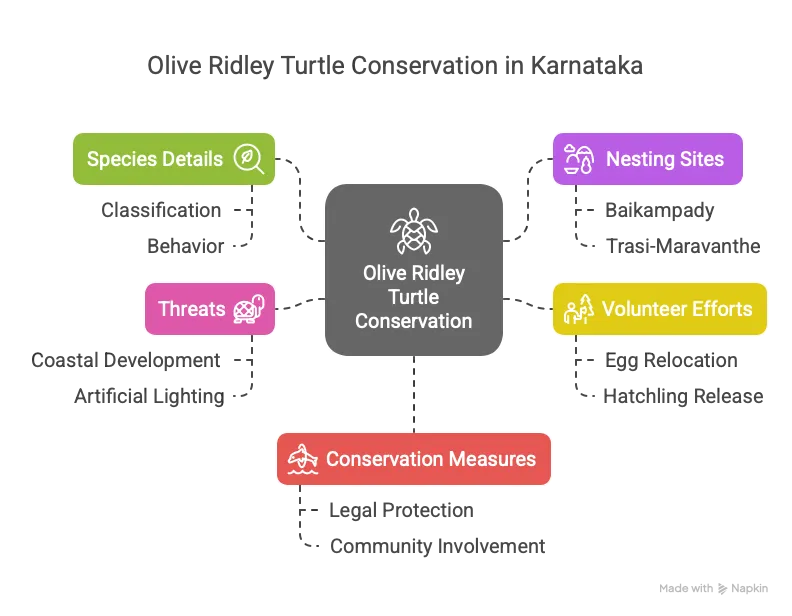UPSC
The Hindu Briefs
Turtle Conservation in Coastal Karnataka: Environmental Insights
Last Updated
4th April, 2025
Date Published
4th April, 2025
Share This Post With Someone

The annual nesting of Olive Ridley turtles along Karnataka's coast highlights critical environmental conservation efforts, offering insights into biodiversity, ecological challenges, and policy implications relevant for aspirants preparing for competitive examinations.

Information in Points:
- Event and Location: Hundreds of Olive Ridley turtle hatchlings emerged on Karnataka’s beaches, specifically at Kundapur in Udupi district and Baikampady in Dakshina Kannada district, marking the annual nesting season.
- Species: The Olive Ridley turtle (Lepidochelys olivacea) is classified as vulnerable by the IUCN Red List, emphasizing its conservation significance.
- Nesting Sites: Key nesting locations include a 2-km stretch at Baikampady near the Central Marine Fisheries Research Institute (CMFRI) hatchery and Trasi-Maravanthe in Kundapur.
- Volunteer Efforts: Volunteers and local fishermen at Baikampady collected over 100 eggs from two nests, relocating them to the CMFRI hatchery for protection.
- Hatchery Details: The CMFRI hatchery at Baikampady, operational since 2022, has a capacity for 3,000 eggs and has released approximately 900 hatchlings over three years.
- Incubation Period: Eggs take 45 to 60 days to hatch, with 81 hatchlings released into the sea on a single day at Baikampady in 2025.
- Conservation History: Turtle conservation in Karnataka began in the 1980s with forest department surveys identifying 11 nesting sites across Udupi, Dakshina Kannada, and Uttara Kannada districts.
- Scale of Nesting: Karnataka’s coast hosts about 2,500 Olive Ridley turtle nests annually, a smaller number compared to Odisha’s mass nesting events.
- Threats: Major threats include coastal development, artificial lighting, and fishing nets, which endanger turtle eggs and hatchlings.
- Female Nesting Behavior: Female Olive Ridley turtles return to their natal beaches to lay eggs, with each laying around 100 eggs per clutch.
- Conservation Measures: At Trasi-Maravanthe, 14 nests with 1,316 eggs were recorded this season, with hatchlings released back into the sea under forest department supervision.
- Temperature Impact: Nest temperatures above 31°C produce female hatchlings, while lower temperatures yield males, a factor influencing population dynamics amid climate change.
- Legal Protection: Olive Ridley turtles are protected under Schedule I of the Wildlife Protection Act, 1972, ensuring stringent conservation measures.
- Historical Efforts: Earlier conservation attempts in the 1990s failed due to poor hatchery management, but recent efforts show improved success with community and institutional involvement.
- Regional Comparison: Unlike Odisha’s mass nesting (arribada), Karnataka experiences sporadic nesting, reflecting regional ecological differences.
Glossary
- Olive Ridley Turtle: A vulnerable marine species known for nesting on coastal beaches.
- IUCN Red List: A global inventory assessing the conservation status of species.
- CMFRI Hatchery: A facility by the Central Marine Fisheries Research Institute for turtle egg incubation and hatchling release.
- Natal Beach: The birth beach where turtles return to lay eggs.
- Arribada: Mass nesting phenomenon, notably seen in Odisha.
- Wildlife Protection Act, 1972: Indian legislation providing legal safeguards to wildlife, including turtles.
- Coastal Development: Human activities along coastlines threatening turtle habitats.
- Artificial Lighting: Man-made light disrupting turtle nesting and hatchling navigation.
Link To The Original Article – https://www.thehindu.com/news/national/karnataka/its-turtle-time-in-coastal-karnataka/article69404946.ece